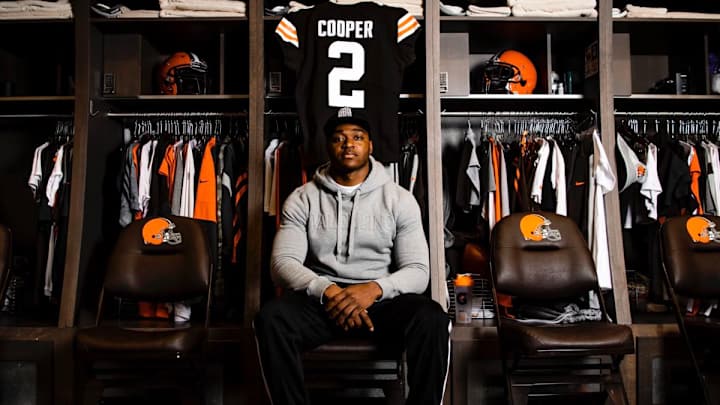Amari Cooper to Browns OFFICIAL: Worst Trade in Cowboys History?

No, they're not saying "Cooooooop!" When it comes to the Dallas Cowboys trading for receivers, their fans are indeed screaming "boooooo!"
Jerry Jones drafted the franchise's all-time leaders in receptions and receiving yards (Jason Witten) and receiving touchdowns (Dez Bryant). Jay Novacek and Terrell Owens were productive after signing in Dallas as free agents. The Cowboys have even been successful in developing undrafted receivers such as Miles Austin and Cole Beasley.
Cleveland's Cooper
Amari Cooper
Jerry Jones
But when it comes to coveting - and acquiring - another team's receiver, Jones has an ugly track record that just became more hideous via last week's desperate dealing of Amari Cooper to the Cleveland Browns. ... a deal that on Wednesday went official. ... complete with Cooper's new jersey and number photo released by the Browns.
In their latest receiver tragic trick, the Cowboys turned a first-round draft pick into a fifth. And during the four-season period that Cooper's value was deteriorating, he helped Dallas win only one playoff game - a home Wild Card game over the Seattle in 2018.
Sadly for Jones, Cooper isn't his worst receiver trade. The terrible trio:
3. AMARI COOPER, 2018 - The Cowboys gave up their first-round pick in 2019 (27th overall) to get Cooper from the Raiders in 2018. The real problem came two years later, when Jones signed him to a five-year, $100 contract.
Facing paying a declining player - who seemingly quit during last season's playoff to the 49ers - $20 million, the Cowboys considered cutting Cooper before salvaging a fifth-round pick.
The stink of this trade isn't all on Cooper. He was more productive in Dallas than with the Raiders, and made the Pro Bowl 2018-19. But because of Jones' other contractual gaffes - dragging out (and thereby escalating) contract talks with players such as DeMarcus Lawrence and Dak Prescott and prematurely rewarding Ezekiel Elliott despite two years remaining on his rookie deal - Cooper became a luxury the Cowboys could no longer afford.
When he wouldn't agree to a pay cut after a sub-par season, he was salvaged.
2. JOEY GALLOWAY, 2000 - With Troy Aikman's career taking its last gasps and Michael Irvin freshly retired, Jones needed a receiver ... and a splash. So he sent two - yes two - first-round draft picks to Seattle for Joey Galloway.
This wasn't totally Jones' miscalculation, but the bottom line was a catastrophe as the speedster suffered a torn ACL in his first game. In four seasons in Dallas, Galloway caught only four touchdowns. Worse, Aikman retired after 2000 and Jones had no high draft with which to rebuild, much less find a new franchise quarterback.
Enter, Quincy Carter.
But wait, it gets worse. In 2004 Jones dealt Galloway to the Buccaneers for 32-year-old Keyshawn Johnson. In Tampa, Galloway resurrected his career and produced three consecutive 1,000-yard seasons. And in Seattle, one of the first-round picks acquired from the Cowboys turned into 2005 NFL Most Valuable Player Shaun Alexander.
Ouch.
Amari Cooper
Troubled Trio
Roy Williams
1. ROY WILLIAMS, 2008 - Even after the Galloway debacle, Jones didn't learn his lesson about mortgaging his team's future for risky receivers.
In what is widely recognized as the worst trade in Cowboys history - Jones publicly admits "I'd like to have that one back." - they sent a first-, third- and sixth-round pick to the Lions for the 2006 Pro Bowl receiver. To make matters worse - similar to Cooper - Jones immediately signed Williams to a $54 million contract.
Supposedly paired with Owens to give emerging quarterback Tony Romo an elite receiving duo on a team with Super Bowl potential, Williams instead never topped 40 catches or 600 yards in his only two seasons in Dallas.
The Cowboys cut Williams before training camp in 2011.

Richie Whitt has been a sports media fixture in Dallas-Fort Worth since graduating from UT-Arlington in 1986. His career is highlighted by successful stints in print (Fort Worth Star-Telegram, Dallas Observer), TV (NBC5) and radio (105.3 The Fan). During his almost 40-year tenure, he's blabbed and blogged on events ranging from Super Bowls to NBA Finals to World Series to Stanley Cups to Olympics to Wimbledons to World Cups. Whitt has been covering the NFL since 1989, and in 1993 authored The 'Boys Are Back, a book chronicling the Dallas Cowboys' run to Super Bowl XXVII.
Follow richiewhitt